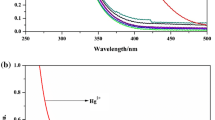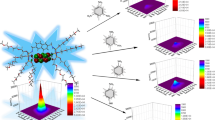Abstract
Based on the photoinduced electron transfer (PET) principle, 4-amino-7-nitro-2,1,3-benzoxadiazole (ANBD) has been used as a fluorophore to develop a new fluorescent probe, 4-(2-N,N-dimethylthioacetamide)amino-7-nitro-2,1,3-benzoxadiazole (2), for the detection of Hg2+. Upon the addition of Hg2+, a 46-fold fluorescence enhancement occurs. Moreover the probe 2 exhibits a high selectivity and sensitivity to Hg2+, even in the presence of other common metal ions. Under optimal reaction conditions, a good linearity can be obtained in the range of 0.5–2.5 μM, and the detection limit is 0.05 μM. In addition, the desulfurization reaction mechanism is proposed based on electrospray ionization mass spectrum. The present study is not only a supplement to the detection method of Hg2+, but also a merit to the development of ANBD-based fluorescent probes.










Similar content being viewed by others
References
Renzoni A, Zino F, Franchi E (1998) Mercury levels along the food chain and risk for exposed populations. Environ Res 77:68–72
Von Burg R, Greenwood MR (1991) Metals and their compounds in the environment. VCH, Weinheim, pp 1045–1088
Boening DW (2000) Ecological effects, transport, and fate of mercury: a general review. Chemosphere 40:1335–1351
Richardson SD, Temes TA (2005) Water analysis: emerging contaminants and current issues. Anal Chem 77:3807–3838
Takeuchi T, Morikawa N, Matsumoto H, Shiraishi Y (1962) A pathological study of Minamata disease in Japan. Acta Neuropathol 2:40–57
Harada M (1995) Minamata disease: methylmercury poisoning in Japan caused by environmental pollution. Crit Rev Toxicol 25:1–24
Carvalho CML, Chew EH, Hashemy SI, Lu J, Holmgren A (2008) Inhibition of the human thioredoxin system-a molecular mechanism of mercury toxicity. J Biol Chem 283:11913–11923
Clarkson TW, Magos L, Myers GJ (2003) The toxicology of mercury-current exposures and clinical manifestations. New Eng J Med 349:1731–1737
Shafawi A, Ebdon L, Foulkes M, Stockwell P, Corns W (1999) Determination of total mercury in hydrocarbons and natural gas condensate by atomic fluorescence spectrometry. Analyst 124:185–189
Yamini Y, Alizadeh N, Shamsipur M (1997) Solid phase extraction and determination of ultra trace amounts of mercury(II) using octadecyl silica membrane disks modified by hexathia-18-crown-6-tetraone and cold vapour atomic absorption spectrometry. Anal Chim Acta 355:69–74
Legrand M, Lam R, Jensen-Fontaine M, Salin ED, Chan HM (2004) Direct detection of mercury in single human hair strands by laser ablation inductively coupled plasma mass spectrometry (LA-ICP-MS). J Anal At Spectrom 19:1287–1288
Nolan EM, Lippard SJ (2008) Tools and tactics for the optical detection of mercuric ion. Chem Rev 108:3443–3480
Kim HN, Ren WX, Kim JS, Yoon J (2012) Fluorescent and colorimetric sensors for detection of lead, cadmium, and mercury ions. Chem Soc Rev 41:3210–3244
Zheng H, Zhan XQ, Bian QN, Zhang XJ (2013) Advances in modifying fluorescein and rhodamine fluorophores as fluorescent chemosensors. Chem Commun 49:429–447
Mahato P, Saha S, Das P, Agarwalla H, Das A (2014) An overview of the recent developments on Hg2+ recognition. RSC Adv 4:36140–36174
Hien NK, Bao NC, Nhung NTA, Trung NT, Nam PC, Duong T, Kim JS, Quang DT (2015) A highly sensitive fluorescent chemosensor for simultaneous determination of Ag(I), Hg(II), and Cu(II) ions: design, synthesis, characterization and application. Dyes Pigments 116:89–96
Vengaian KM, Britto CD, Sekar K, Sivaramanb G, Singaravadivel S (2016) Phenothiazine-diaminomalenonitrile based colorimetric and fluorescence “turn-off-on” sensing of Hg2+ and S2−. Sensors Actuators B Chem 235:232–240
Li D, Li CY, Li YF, Li Z, Xu F (2016) Rhodamine-based chemodosimeter for fluorescent determination of Hg2+ in 100% aqueous solution and in living cells. Anal Chim Acta 934:218–225
Saleem M, Rafiq M, Hanif M (2017) Organic material based fluorescent sensor for Hg2+: a brief review on recent development. J Fluoresc 27:31–58
Banthia S, Samanta A (2006) A new strategy for ratiometric fluorescence detection of transition metal ions. J Phys Chem B 110:6437–6440
Jiang W, Fu Q, Fan H, Wang W (2008) An NBD fluorophore-based sensitive and selective fluorescent probe for zinc ion. Chem Comm 259-261
Qian F, Zhang C, Zhang Y, He W, Gao X, Hu P, Guo Z (2009) Visible light excitable Zn2+ fluorescent sensor derived from an intramolecular charge transfer fluorophore and its in vitro and in vivo application. J Am Chem Soc 131:1460–1468
Boiocchi M, Fabbrizzi L, Licchelli M, Sacchi D, Vázquezb M, Zampa C (2003) A two-channel molecular dosimeter for the optical detection of copper(II). Chem Commun:1812–1813
Banthia S, Samanta A (2005) A two-dimensional chromogenic sensor as well as fluorescence inverter: selective detection of copper(II) in aqueous medium. New J Chem 29:1007–1010
Liu SR, Wu SP (2011) An NBD-based sensitive and selective fluorescent sensor for copper(II) ion. J Fluoresc 21:1599–1605
Sakamoto H, Ishikawa J, Nakao S, Wada H (2000) Excellent mercury(II) ion selective fluoroionophore based on a 3,6,12,15-tetrathia-9-azaheptadecane derivative bearing a nitrobenzoxadiazolyl moiety. Chem Comm 2395–2396
Kim SH, Kim JS, Park SM, Chang SK (2006) Hg2+-selective off-on and Cu2+-selective on-off type fluoroionophore based upon cyclam. Org Lett 8:371–374
Wanichacheva N, Siriprumpoonthum M, Kamkaew A, Grudpan K (2009) Dual optical detection of a novel selective mercury sensor based on 7-nitrobenzo-2-oxa-1,3-diazolyl subunits. Tetrahedron Lett 50:1783–1786
Lee JE, Lee SS, Choi KS (2010) A chromo- and fluoroionophoric thiaoxaaza-macrocycle functionalized with nitrobenzofurazan exhibiting mercury (II) selectivity. Bull Kor Chem Soc 31:3707–3710
Jeong HJ, Li Y, Hyun MH (2011) A fluorescent chemosensor based on 7-Nitrobenz-2-oxa-1,3-diazole (NBD) for the selective detection of hg(II). Bull Kor Chem Soc 32:2809–2812
Ruan YB, Maisonneuve S, Xie J (2011) Highly selective fluorescent and colorimetric sensor for Hg2+ based on triazole-linked NBD. Dyes Pigments 90:239–244
Xie Z, Wang K, Zhang C, Yang Z, Chen Y, Guo Z, Lu GY, He W (2011) A fluorometric/colorimetric dual-channel Hg2+ sensor derived from a 4-amino-7-nitro-benzoxadiazole (ANBD) fluorophore. New J Chem 35:607–613
Wang K, Yang L, Zhao C, Ma H (2013) 4-(8-Quinolyl)amino-7-nitro-2,1,3- benzoxadiazole as a new colorimetric probe for rapid and visual detection of Hg2+. Spectrochim Acta A 105:29–33
Kim JH, Noh JY, Hwang IH, Lee JJ, Kim C (2013) A NBD-based selective colorimetric and fluorescent chemosensor for Hg2+. Tetrahedron Lett 54:4001–4005
Choi J, Lee SK, Bae J, Chang SK (2014) Colorimetric signaling of Hg2+ ions by a nitrobenzoxadiazole-appended cyclen-triester. Tetrahedron Lett 55:5294–5297
Zhang Y, Chen H, Chen D, Wu D, Chen Z, Zhang J, Chen X, Liu S, Yin J (2016) A colorimetric and ratiometric fluorescent probe for mercury (II) inlysosome. Sensors Actuators B Chem 224:907–914
Chae MY, Czarnik AW (1992) Fluorometric chemodosimetry. Mercury (II) and silver (I) indication in water via enhanced fluorescence signaling. J Am Chem Soc 114:9704–9705
Song KC, Kim JS, Park SM, Chung KC, Ahn S, Chang SK (2006) Fluorogenic Hg2+-selective chemodosimeter derived from 8-hydroxyquinoline. Org Lett 8:3413–3416
Daly B, Ling J, de Silva AP (2015) Current developments in fluorescent PET (photoinduced electron transfer) sensors and switches. Chem Soc Rev 44:4203–4211
Huang J, Ma X, Liu B, Cai L, Li Q, Zhang Y, Jiang K, Yin S (2013) A colorimetric and ratiometric turn-on BODIPY-based fluorescent probe for double-channel detection of Cu2+ and Hg2+. J Lumin 141:130–136
Coronado E, Galán-Mascarós JR, Martí-Gastaldo C, Palomares E, Durrant JR, Vilar R, Gratzel M, Nazeeruddin MK (2005) Reversible colorimetric probes for mercury sensing. J Am Chem Soc 127:12351–12356
Acknowledgements
We gratefully acknowledge the financial support from the Natural Science Foundation of Hebei Province, China (No. B2013106116).
Author information
Authors and Affiliations
Corresponding authors
Rights and permissions
About this article
Cite this article
Wang, K., Mao, X., Cao, L. et al. A new 4-Amino-7-Nitro-2,1,3-Benzoxadiazole (ANBD)-Based Fluorescent Probe for the Detection of Hg2+ . J Fluoresc 27, 1739–1745 (2017). https://doi.org/10.1007/s10895-017-2112-4
Received:
Accepted:
Published:
Issue Date:
DOI: https://doi.org/10.1007/s10895-017-2112-4




